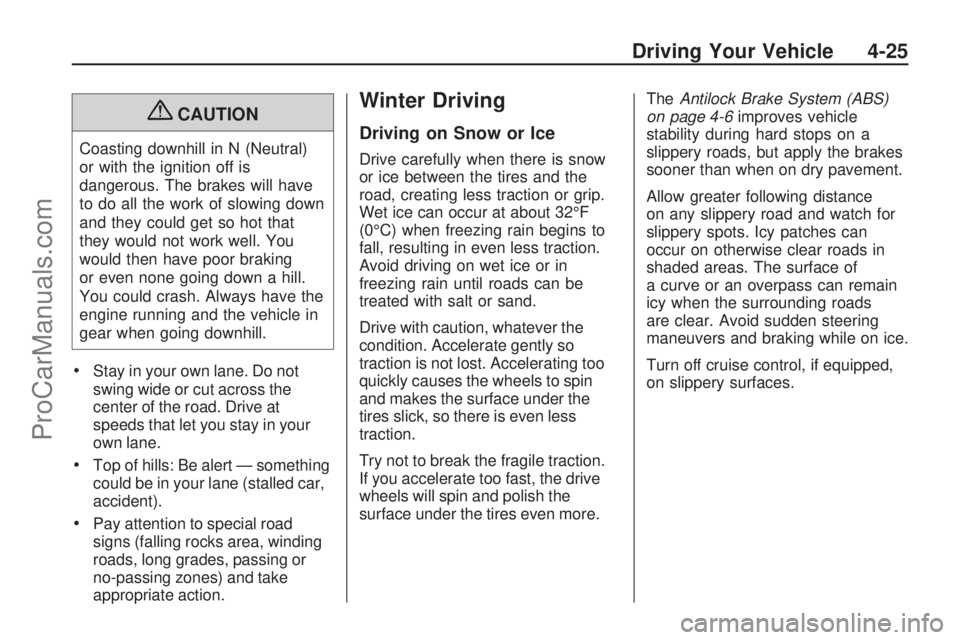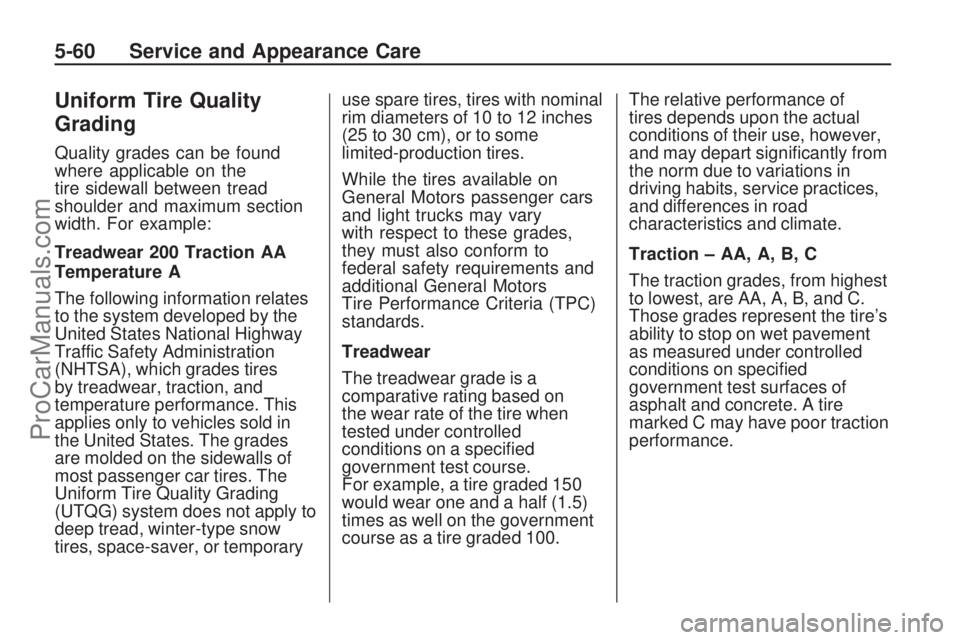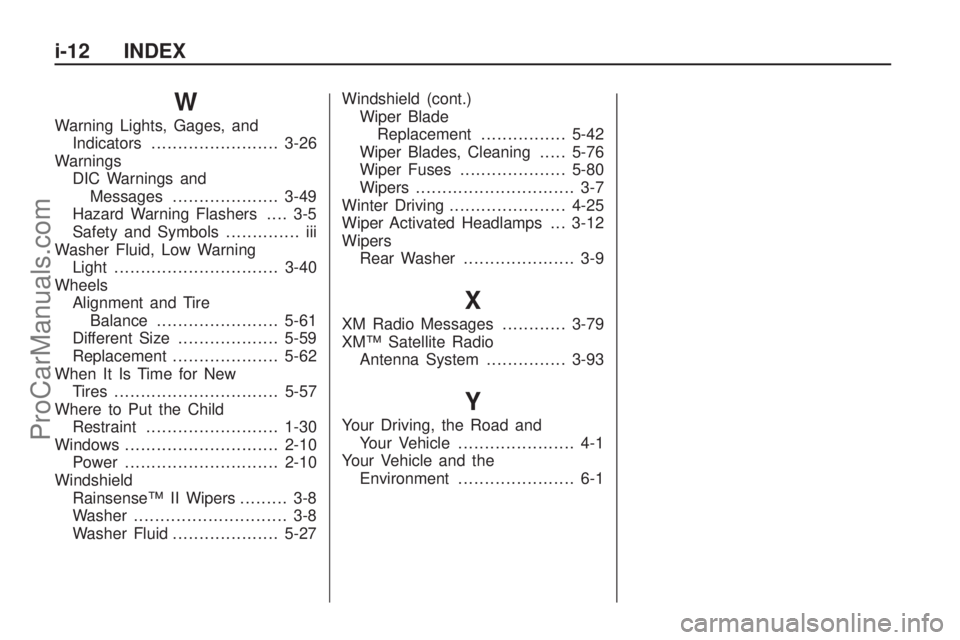winter tires SATURN VUE 2009 Owners Manual
[x] Cancel search | Manufacturer: SATURN, Model Year: 2009, Model line: VUE, Model: SATURN VUE 2009Pages: 386, PDF Size: 2.3 MB
Page 229 of 386

{CAUTION
Coasting downhill in N (Neutral)
or with the ignition off is
dangerous. The brakes will have
to do all the work of slowing down
and they could get so hot that
they would not work well. You
would then have poor braking
or even none going down a hill.
You could crash. Always have the
engine running and the vehicle in
gear when going downhill.
Stay in your own lane. Do not
swing wide or cut across the
center of the road. Drive at
speeds that let you stay in your
own lane.
Top of hills: Be alert — something
could be in your lane (stalled car,
accident).
Pay attention to special road
signs (falling rocks area, winding
roads, long grades, passing or
no-passing zones) and take
appropriate action.
Winter Driving
Driving on Snow or Ice
Drive carefully when there is snow
or ice between the tires and the
road, creating less traction or grip.
Wet ice can occur at about 32°F
(0°C) when freezing rain begins to
fall, resulting in even less traction.
Avoid driving on wet ice or in
freezing rain until roads can be
treated with salt or sand.
Drive with caution, whatever the
condition. Accelerate gently so
traction is not lost. Accelerating too
quickly causes the wheels to spin
and makes the surface under the
tires slick, so there is even less
traction.
Try not to break the fragile traction.
If you accelerate too fast, the drive
wheels will spin and polish the
surface under the tires even more.TheAntilock Brake System (ABS)
on page 4-6improves vehicle
stability during hard stops on a
slippery roads, but apply the brakes
sooner than when on dry pavement.
Allow greater following distance
on any slippery road and watch for
slippery spots. Icy patches can
occur on otherwise clear roads in
shaded areas. The surface of
a curve or an overpass can remain
icy when the surrounding roads
are clear. Avoid sudden steering
maneuvers and braking while on ice.
Turn off cruise control, if equipped,
on slippery surfaces.
Driving Your Vehicle 4-25
ProCarManuals.com
Page 308 of 386

Uniform Tire Quality
Grading
Quality grades can be found
where applicable on the
tire sidewall between tread
shoulder and maximum section
width. For example:
Treadwear 200 Traction AA
Temperature A
The following information relates
to the system developed by the
United States National Highway
Traffic Safety Administration
(NHTSA), which grades tires
by treadwear, traction, and
temperature performance. This
applies only to vehicles sold in
the United States. The grades
are molded on the sidewalls of
most passenger car tires. The
Uniform Tire Quality Grading
(UTQG) system does not apply to
deep tread, winter-type snow
tires, space-saver, or temporaryuse spare tires, tires with nominal
rim diameters of 10 to 12 inches
(25 to 30 cm), or to some
limited-production tires.
While the tires available on
General Motors passenger cars
and light trucks may vary
with respect to these grades,
they must also conform to
federal safety requirements and
additional General Motors
Tire Performance Criteria (TPC)
standards.
Treadwear
The treadwear grade is a
comparative rating based on
the wear rate of the tire when
tested under controlled
conditions on a speci�ed
government test course.
For example, a tire graded 150
would wear one and a half (1.5)
times as well on the government
course as a tire graded 100.The relative performance of
tires depends upon the actual
conditions of their use, however,
and may depart signi�cantly from
the norm due to variations in
driving habits, service practices,
and differences in road
characteristics and climate.
Traction – AA, A, B, C
The traction grades, from highest
to lowest, are AA, A, B, and C.
Those grades represent the tire’s
ability to stop on wet pavement
as measured under controlled
conditions on speci�ed
government test surfaces of
asphalt and concrete. A tire
marked C may have poor traction
performance.
5-60 Service and Appearance Care
ProCarManuals.com
Page 376 of 386

Audio System (cont.)
Setting the Clock..............3-65
XM™ Satellite Radio
Antenna System............3-93
Audio System(s)..................3-67
Audio Systems
Radio Reception...............3-92
Theft-Deterrent Feature......3-91
Automatic Climate Control
System...........................3-20
Automatic Door Lock.............. 2-8
Automatic Door Unlock........... 2-8
Automatic Headlamp
System...........................3-13
Automatic Transmission
Fluid...............................5-18
Operation................2-19, 2-22
B
Battery...............................5-30
Electric Power
Management.................3-15
Run-Down Protection.........3-16
Belt Routing, Engine.............6-16
Bluetooth
®..........................3-81
Brake
Emergencies...................... 4-6
Brake Fluid.........................5-28Brakes...............................5-28
Antilock............................. 4-6
Parking...........................2-24
System Warning Light.......3-31
Braking................................ 4-5
Braking in Emergencies.......... 4-6
Break-In, New Vehicle..........2-15
Bulb Replacement................5-41
Fog Lamp ........................3-14
Front Turn Signal and
Parking Lamps..............5-40
Halogen Bulbs..................5-39
Headlamp Aiming..............5-36
Headlamps......................5-39
License Plate Lamps.........5-41
Taillamps, Turn Signal,
Stoplamps and Back-up
Lamps .........................5-40
Buying New Tires.................5-58
C
Calibration..........................3-47
California
Perchlorate Materials
Requirements................. 5-4
California Fuel....................... 5-6
California Proposition 65
Warning............................ 5-4Camera, Rear Vision............2-31
Canadian Owners..................... ii
Capacities and
Speci�cations...................5-86
Carbon Monoxide
Engine Exhaust................2-28
Liftgate............................. 2-9
Winter Driving..................4-25
Care of
Safety Belts.....................5-74
Cargo
Tie Downs .......................2-44
Cargo Cover.......................2-44
Cargo Management System . . . 2-44
CD, MP3 ............................3-75
Center Console Storage........2-42
Chains, Tire........................5-62
Charging System Light..........3-31
Check
Engine Lamp...................3-35
Checking Things Under
the Hood .........................5-10
Chemical Paint Spotting........5-78
Child Restraints
Infants and Young
Children.......................1-26
Lower Anchors and
Tethers for Children.......1-31
i-2 INDEX
ProCarManuals.com
Page 386 of 386

W
Warning Lights, Gages, and
Indicators........................3-26
Warnings
DIC Warnings and
Messages....................3-49
Hazard Warning Flashers.... 3-5
Safety and Symbols.............. iii
Washer Fluid, Low Warning
Light...............................3-40
Wheels
Alignment and Tire
Balance.......................5-61
Different Size...................5-59
Replacement....................5-62
When It Is Time for New
Tires...............................5-57
Where to Put the Child
Restraint.........................1-30
Windows.............................2-10
Power .............................2-10
Windshield
Rainsense™ II Wipers......... 3-8
Washer............................. 3-8
Washer Fluid....................5-27Windshield (cont.)
Wiper Blade
Replacement................5-42
Wiper Blades, Cleaning.....5-76
Wiper Fuses....................5-80
Wipers.............................. 3-7
Winter Driving......................4-25
Wiper Activated Headlamps . . . 3-12
Wipers
Rear Washer..................... 3-9
X
XM Radio Messages............3-79
XM™ Satellite Radio
Antenna System...............3-93
Y
Your Driving, the Road and
Your Vehicle...................... 4-1
Your Vehicle and the
Environment...................... 6-1
i-12 INDEX
ProCarManuals.com